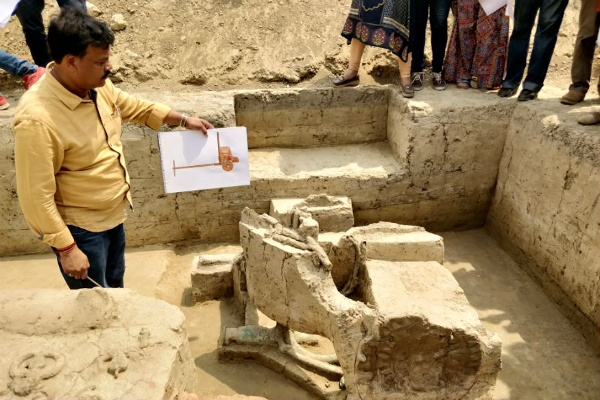NEW DELHI: Senior archaeologists at the Archaeological Survey of India (ASI) claimed on Friday that the Sanskrit epic Mahabharata could date back to 1500-2000 BCE, instead of 900-1000 BCE as commonly believed on the basis of the findings of renowned archaeologist BB Lal.
The claim follows the findings at the excavation site of Sanauli, 68 km away from Delhi, last year, including the discovery of a “war chariot” allegedly driven by a horse, a rusted bow and arrow, a burial site and ochre coloured pottery, war shields, whip, torch and an antennae sword with hilt.
These findings were discussed on Friday by the director of the ASI’s Institute of Archaeology, Sanjay Manjul, who had carried out the Sanauli excavation. Manjul said the war chariot found at the site was the first discovery of its kind and that after advanced testing it was found to be “a horse-pulled” one, which brings the site “closer to the culture of Mahabharata”.
“The whip we have discovered is specifically the one that is used on a horse, not a bull. The wheels, pole and yoke are solid, with copper triangles. The helmets, shields are sophisticated. The Sanauli findings are a missing link with the Rigvedic culture and a sign of our civilisational continuity. Chariots figure prominently in Rigveda, Ramayana and Mahabharata,” he said.
Manjul said his team was revisiting the findings of BB Lal, had who carried out excavations at Indraprastha and Hastinapur in 1951-52. Lal had revealed that around 800 BC a heavy flood in the Ganga had destroyed a considerable portion of the settlement. Based on the relics recovered, he had termed the period painted grey ware (PGW) culture, and had said that this was the earliest common pottery connecting all the Mahabharata sites such as Hastinapur, Mathura, Kurukshetra and Kampilya.
Lal had also estimated that the battle in Kurukshetra to have taken place around 800 BC and had said that the capital was shifted to Kaushambi from Hastinapur during the time of Nichasku, who was the fifth ruler after Parikshit, who ascended the throne after the war, while Udayana, the contemporary of Buddha, was the 19th in the Kuru clan. According to Lal’s research, Udayana would have ruled around 500 BCE, after which there were 24 rulers who ruled for 15 years each.
It is with these calculations that Lal had bracketed the period of the Mahabharata around 900 BC.
“The OCP/copper hoard culture of 2600-1700 BC is known for its urban culture, advanced weapons, daggers, shields, copper, chariots, metal pots, and similarity with vedic rituals which had more similarity with the Mahabharata as we know. We have had evidence of this in some places associated with the Mahabharata including Meerut. But the existing dates are based on the PGW culture which had rural settlements, no chariots, limited pottery and few rituals. These don’t corroborate with the literature evidence of the Mahabharata too,” he said.
Manjul has also looked into the genealogy of the Kuru kings, starting from Pratipa leading to Dhiritrashtra, Pandu and Yudhisthir in the fifth, sixth, seventh ranks, and ending with the 36th king Kshemaka, who is preceded by Iramitra. “The contemporary of Buddha was around 550 BCE which was the 23rd generation of the Kuru kings. If, on average, you give 50 years each to the kings, which reduces in the later generations with frequent wars, the dating of the Mahabharata is around 1750 BCE,” he said.
While the genetic sequencing of the Sanauli findings is underway, Manjul said the ASI team has used several scientific techniques such as X-Ray, CT Scan, 3D scanning, photogrammetry and GPR survey to be sure of its accuracy. Since the first excavations at Indraprastha in early 1950s, there have been at least eight excavations at places mentioned in the Mahabharata, but the ASI now has not published any conclusive, direct or genetic evidence so far to establish historical facts.
Source: ET
Image Courtesy: ISVARA
You may also like
-
India Can’t Afford to Remain Stagnant at this Juncture, Says PM Modi; Asks People to Buy Locally-Made Goods
-
Stolen Artefacts to be Returned to India from Scotland Museums
-
Netaji’s Hologram Statue at India Gate
-
10th Century Stone Idol of Goat Head Yogini IllegallyRemoved from A Temple in Lokhari, Banda, UP Being Returned to India
-
UNESCO Inscribes ‘Durga Puja in Kolkata’ on the Representative List of Intangible Cultural Heritage of Humanity
